Flying Elephant Super Heavy Tank Project (UK)
The first British tanks, as later showed the battles in the fields of the First World War, could have the most serious impact on the course of the battle. However, already at the stage of development and testing of this technique, its main drawbacks were identified. The main problems were considered low speed on rough terrain and relatively thin armor. A combat vehicle that was not protected by an inch-thick armor, moving at the speed of an infantryman, could have been an easy target for artillery. Medium-sized or large-caliber weapons could penetrate armor and destroy a tank. Thus, the most convenient and promising way to modernize technology was an increase in armor thickness. Nevertheless, the refinement of existing tanks was considered impractical. Thicker armor was to be used in a completely new project.
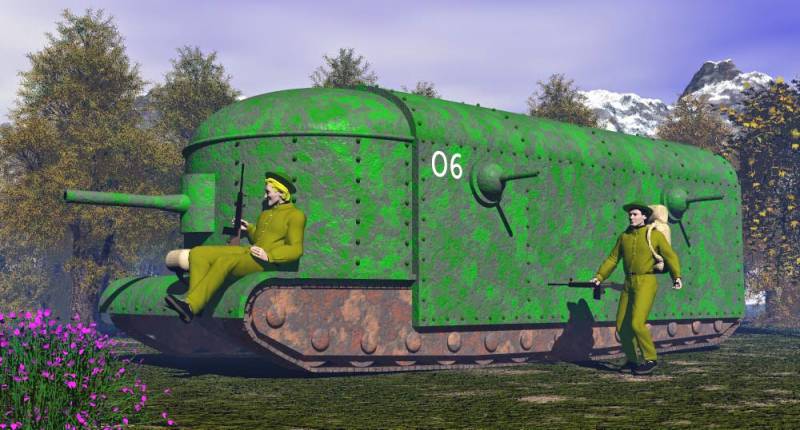
Super heavy tank Flying Elephant B in the view of the artist. Figure Stringbagsandrattleboxes.blogspot.ru
The initiator of the development of the next tank with a serious reservation was Colonel William Tritton, one of the creators of the very first British project of such technology. Already in the spring of 1916, he was preoccupied with the problem of increasing the resistance of the defense, which eventually led to the emergence of a new draft of the combat vehicle. In April, a specialist, after analyzing the existing opportunities, came to the conclusion that it was necessary to create a completely new project in which some existing ideas could be used. At the same time, the necessary innovations required the development of a promising combat vehicle from scratch.
At that time, British specialists had limited knowledge in the field of booking. In particular, there was no information about the power of artillery shells of medium and large caliber, as well as the means of protection against such weapons. Because of this, W. Tritton had to initiate special tests, the purpose of which was to fire various armor from captured guns. By the end of April, 1916, at one of the landfills, began testing 2-inch (50,8 mm) armor by firing from various German-made guns. These tests led by Lieutenant Kenneth Symes.
By June, the gunners and engineers had collected a certain amount of data that was planned to be used when building a promising tank. After that, it was decided to conduct additional tests of armor. The company William Beardmore and Company introduced several types of armor protection with different parameters, which again came under fire from German guns. The second stage of research allowed to confirm part of the theoretical calculations, as well as formulate requirements for a new tank. By mid-June, the test program was completed.
Soon, Colonel Tritton presented the army with a preliminary appearance of a promising tank, resistant to most of the enemy artillery. 19 June 1916, a special commission dealing with armored vehicles, approved this proposal. The author of the idea received permission to develop a new project with the subsequent construction of a prototype. Official permission allowed to complete the design of the tank, and this work took the minimum necessary time. The complete draft of the heavyweight combat vehicle was prepared in late August.
Unlike many other projects of armored vehicles, created in Great Britain during the First World War, the project of W. Tritton did not have time to receive the official name. Because of this, during work, an unofficial nickname was used to designate a new machine. In the future, it became the generally accepted name of the project, under which it remained in stories British tank building. The authors of the development have chosen a working name with a healthy twist of irony: Flying Elephant (“Flying Elephant”). It should be noted, with some of its features, the tank really had to resemble a large animal with a trunk.
The main prerequisite for the emergence of the project was the requirement to increase the level of protection of tanks. Further testing of the produced armor, in turn, made it possible to form an approach to ensuring the protection of the crew and machine units. W. Tritton proposed to equip the “Flying Elephant” with frontal armor 3 inch thick (76,2 mm). The sides and feed should have been protected in the form of 2-inch (50,8 mm) armor plates. In addition, the project used the original design of armor parts, which allowed to reduce their size and weight while providing some increase in the level of protection.
It is known that during the design work, U. Tritton and his colleagues consistently proposed two projects. The first of them was denoted by the additional letter “A”, the second - “B”. The projects differed, first of all, in the case design. The first version of the armored car turned out to be too complicated from the point of view of future production, due to which the shape of the armor units was changed to a more technological one. At the same time, the main ideas were not touched upon, which led to a significant similarity between the two proposed tanks.
Project A proposed the following hull design. A curved unit was used as a frontal part. The functions of the boards and the roof were to perform several curved sheets. In addition, each of these sheets was a roof and two sides, for which they should be bent in the shape of a horseshoe. On the aft of such a hull there was a unit of reduced height, covering part of the chassis. On the frontal part of the body, below the curved part, it was proposed to mount the construction of a triangular profile of rectangular sheets. She had to cover the front of the tracks, and also to some extent protect them.
In the tank museum of Bovington, there is a model of “Flying Elephant”, corresponding to the project “B”. The front part of the hull of such a tank had a lower unit in the form of a protected duct containing a part of the aggregates, as well as serving as the base of the chassis. The caterpillars in front and on top should have covered themselves with a curved splash sheet. The central part of the forehead of the body should have been made of a large, curved armor sheet of adequate thickness. Above it was proposed to place a curved roof part above it. Behind such a forehead, the project provided for the installation of vertical sides, the lower part of which served as the chassis screens. On the sides was a curved roof. In this case, the feed should have been made from a straight sheet with a rounded top. In its center could be installed protruding unit to accommodate some devices.
In all variants of the project, the internal volumes of the corps should have been given for the placement of weapons and crew. The central part of the common compartment was allocated for the installation of two engines. In order to save internal space, it was planned to place the engines one by one along the longitudinal axis of the machine. Behind them were placed transmission units associated with stern drive wheels.
The Flying Elephant tank was supposed to be equipped with two Daimler-Foster 105 horsepower petrol engines. each. With the help of a mechanical transmission, the engines were connected to the chassis units. Unlike some other projects of that time, the engines had to be mated with a common transmission, and not with their own caterpillar each. It was assumed that such a power plant will allow you to have mobility at the level of already created tanks. In addition, to improve the mobility parameters in the project some other ideas were proposed.
The super heavy tank designed by U. Tritton was to be equipped with four tracks. The main ones were two caterpillars that ran along the entire length of the car. The main propulsion unit should have at least 15-16 track rollers on each side, united by several trolleys, front drive wheels with a tension mechanism and aft driving wheels. Because of the long length, the main tracks had to go beyond the dimensions of the habitable part of the hull.
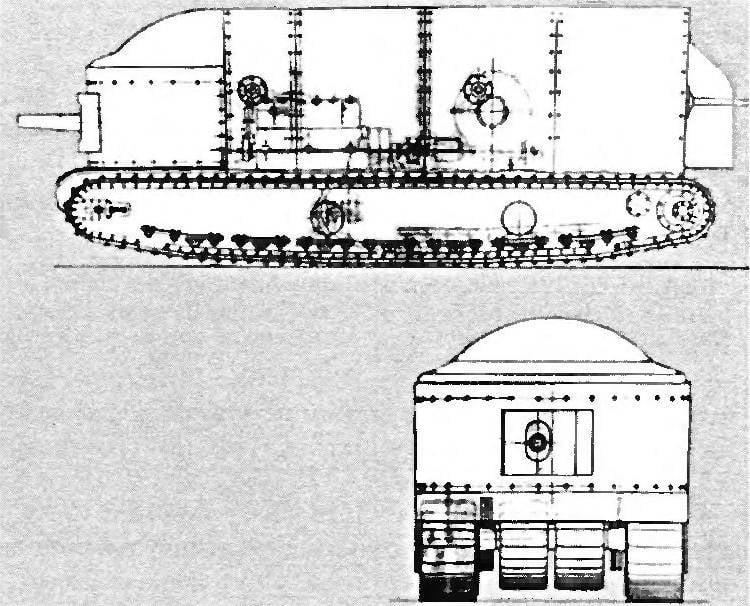
The scheme of the tank Flying Elephant B. Figure S. Fedoseev "Tanks of the First World"
In the stern of the armored vehicle, between the main tracks, it was proposed to place two additional trolleys. They had to get a smaller caterpillar and have a different composition of the main aggregates. The rear drive wheels of small caterpillars with the help of a disengaged clutch could be connected to the drive wheels of the main propulsion unit. Small caterpillars were designed to increase the terrain on difficult landscapes. They could increase the area of adhesion to the surface, as well as help to overcome difficult obstacles. In particular, when hitting a bump or other similar elevation into the space between the main tracks, the tank got a chance to descend from such an obstacle with the help of an additional propulsor. Projects “A” and “B” differed in the length of the additional tracks. In the newer version of the tank, they had to occupy almost half of the total length of the vehicle.
The Flying Elephant was supposed to carry powerful enough weapons. In the frontal parts of the hull provided for turning the installation for the main gun. In the “A” project, the frontal gun was the only machine gun. The second version of the project involved the use of additional weapons. In this case, two additional embrasures were placed on the sides of the hull. Two more such devices could be in the feed sheet.
According to most sources, an 6-pound 57 caliber cannon was to be mounted in a tank head-on. In the opening of the frontal sheet, it was proposed to place the cylindrical device rotatably around a vertical axis. In a cylindrical unit should install swing artillery unit with a movable mask guns. This design allows the installation of fire within a small sector of the front hemisphere.
Apparently, during the elaboration of the project, it was decided that the only gun does not provide the required firepower. Because of this, six additional embrasures appeared in the sides and stern. Serial machine guns of rifle caliber were proposed as auxiliary weapons, which ensured attack targets on the side and rear of the tank.
The crew should have included up to 10 people, depending on the composition of the weapons. Inside the habitable compartment it was planned to locate the commander, driver and his assistant, the calculation of the nose gun, as well as several machine-gunners. All of them were to be in the common compartment, which combines the fighting compartment and the control compartment.
The total length of the Flying Elephant super-heavy tank was to reach 8,4 m, its width and height were about 3 m. According to calculations, the combat weight could exceed 100 t. Because of this, the project authors did not expect to obtain high mobility characteristics. Two engines on 210 hp could not provide high power density. At the same time, such shortcomings were a payment for a high level of protection, which was the main objective of the project.
The development of the project of a promising tank with a high level of protection was completed by the beginning of the autumn 1916 of the year. Soon after, the designers and the military began to address the issue of building a prototype. Until the end of the year, the decision to build was never made. However, the further fate of the development did not last long the subject of controversy. Not later than the beginning of 1917, it was decided to abandon further work. For a number of reasons, the proposed armored vehicle was not of interest to the army. The prototype was never built.
Available information about the Flying Elephant project suggests that a promising tank could have only one positive design feature - a high level of protection. At the same time, thick armor led to a significant weighting of the car, striking mobility. The power density of the 100-ton machine with two engines could not exceed 2,1 HP. per ton. For comparison, Mark I tanks, depending on the modification and weapons, showed power density up to 4 HP. per ton. As a result, the “Flying Elephant” should have been extremely slow. In addition, the car was not able to overcome many obstacles on its own or even get out of the dirt.
Another analysis of the project showed that the new super-heavy tank, despite the highest level of protection and the possibility of survival after a direct hit by various artillery shells, has no real prospects. Unacceptable low speed and poor cross-country ability made it an excellent target for enemy artillery. A massive and coordinated artillery strike, in turn, made the 76,2-mm armor of the tank useless. At the same time, the proposed weapon in the form of 6-pound cannon and machine guns did not give significant advantages over existing and developed tanks.
Also on the future fate of the project could affect some of the views of military leaders. By the end of 1916, the British military had formed the concept that mobility had a higher priority than armor. Indeed, in some situations, high speed and throughput could protect the crew better than armor. The Flying Elephant, unlike other tanks, did not fit these ideas, which further worsened its chances of mass production.
The specific ratio of positive and negative qualities affected the future fate of the project. Not later than the beginning of 1917, Colonel W. Tritton was rejected by a potential customer. All work on the project with the “internal” name of the Flying Elephant should have been stopped due to the lack of prospects. The first prototype, according to some sources, not only was not built, but was not even laid. Naturally, plans for the possible assembly of two dozen tanks of the first batch were rejected.
There are reports of the future of the project. According to these data, in 1917, Colonel Tritton attempted to finalize a promising combat vehicle in order to improve certain characteristics. The new version of the "Flying Elephant" meant the preservation of the general aspects of the design, but was distinguished by a two-fold reduction in booking. Accordingly, the frontal part of the body was equipped with a sheet of 1,5 inch thickness (38,1 mm), sides - 1 inch (25,4 mm). The power plant, chassis, weapons and crew could remain unchanged.
The refined Flying Elephant of the 1917 model of the year was distinguished by a smaller mass and, as a result, a higher power density. The proposed project refinements made it possible to reduce the weight of the structure to 55-60 t. The specific power at the same time should have exceeded 3,5 hp. per ton, which already allowed us to rely on acceptable mobility. The firepower remained at the same level, but there should have been a noticeable reduction in the level of protection. However, in a modified form, the project was of greater interest in comparison with the original version.
The further fate of the updated project “Flying Elephant” is not known for certain. However, the absence of any precise information on this matter clearly indicates that the project - even if it was presented to a potential customer - did not receive approval. All three versions of the U. Tritton design tank never left the drawings, leaving behind an insignificant place in the history of British tank design.
The project of a super-heavy tank under the working title “Flying Elephant” was developed as a solution to one of the main problems of the first tanks of Great Britain. The equipment supplied to the series did not feature a high level of protection, which was why it was decided to create a car with a powerful reservation. However, the thickness of the armor led to an unacceptable increase in the mass of the structure, which could not be compensated by existing engines. The resulting tank should have a low mobility, which is why it could not be of interest to the army. Attempting to refine the original project also did not give tangible results: the updated tank was offered to the military too late. By this time, armored vehicles of new models were adopted, the characteristics of which more fully met the requirements of the army. The projects of W. Tritton in this situation had no real prospects.
Based on:
http://aviarmor.net/
https://civilianmilitaryintelligencegroup.com/
http://wardrawings.be/
Ganfield J. The Devil's Chariots The First World War. Osprey Publishing, 2006
Fletcher D. The British Tanks 1915-19. The Crowood Press, 2001
Fedoseev S. Tanks of the First World War. - M .: Yauza: Eksmo, 2010.
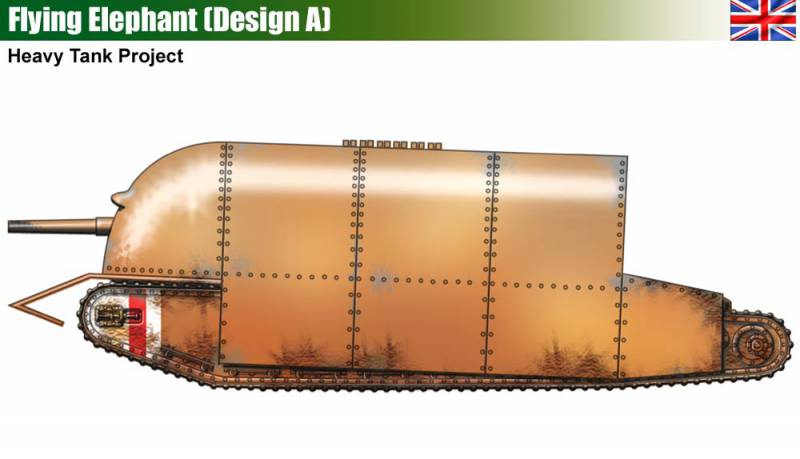
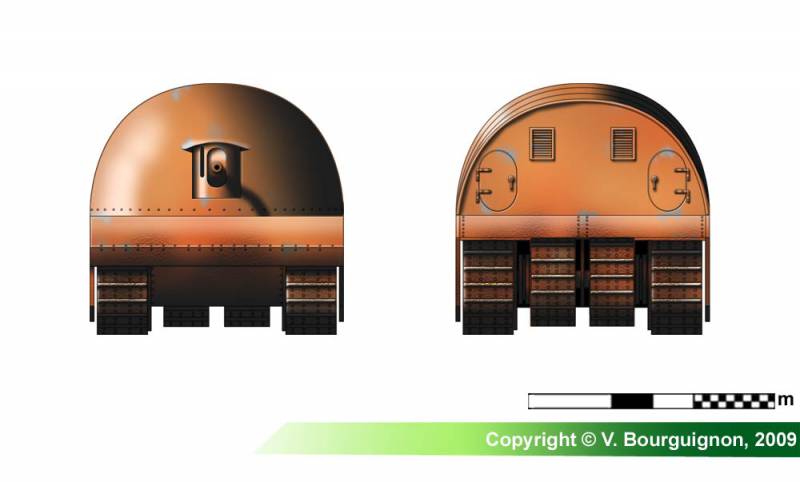
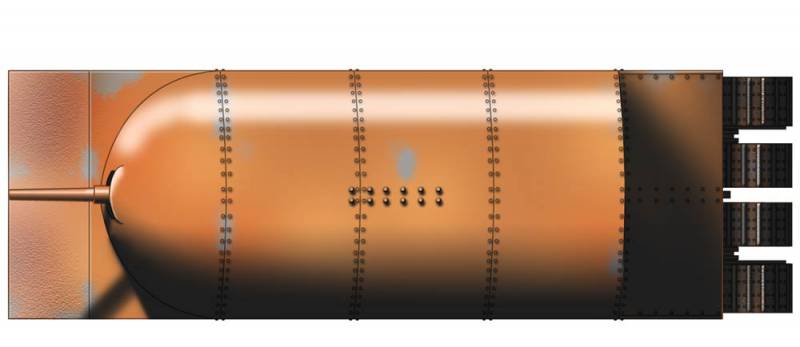
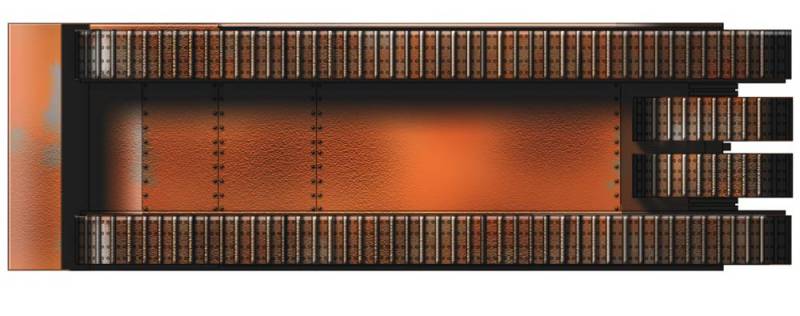
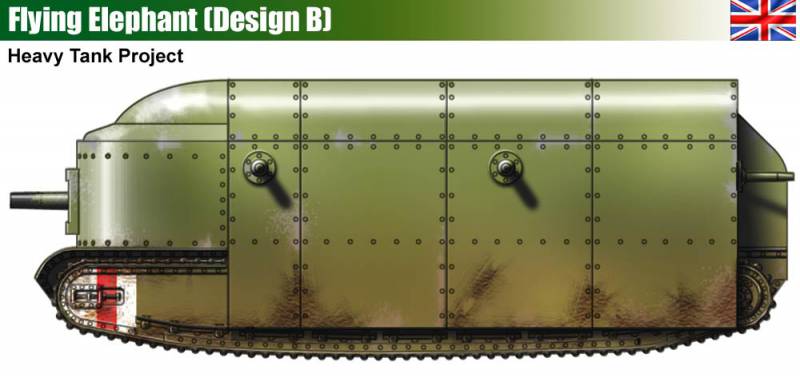
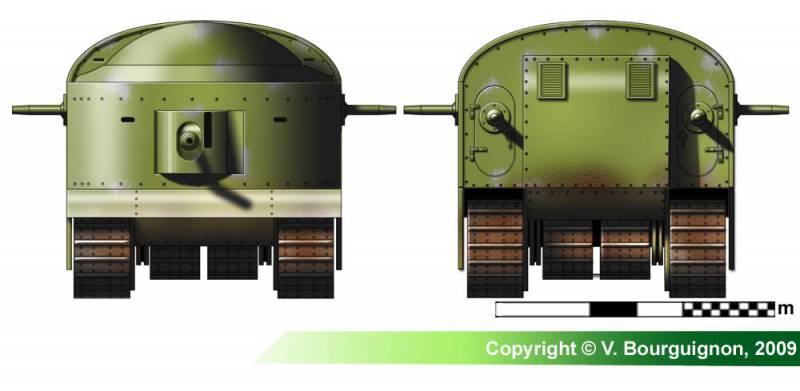
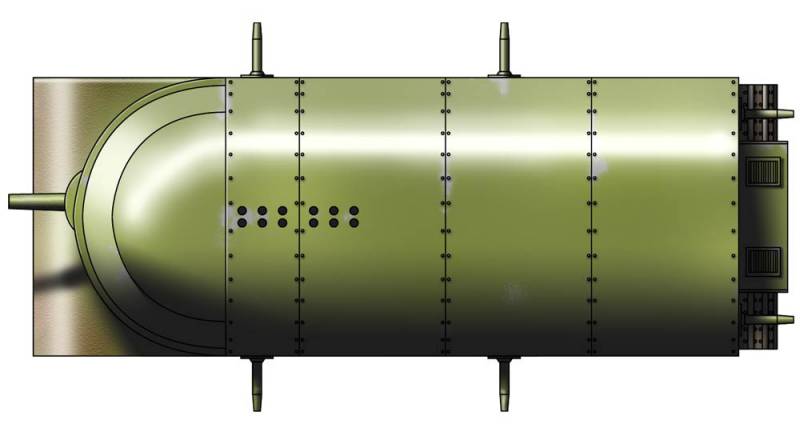
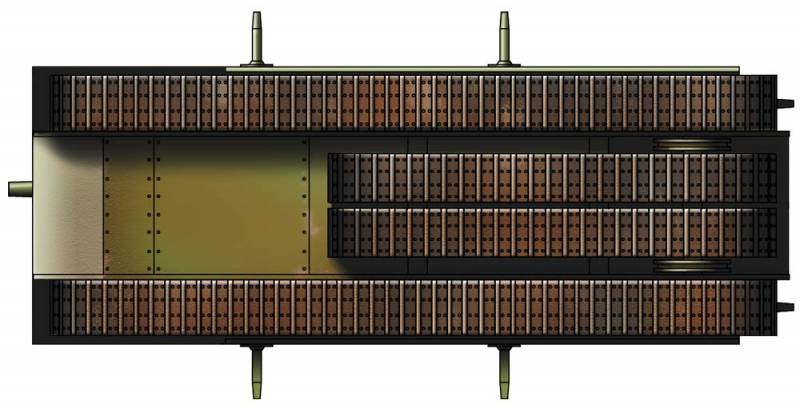
Information